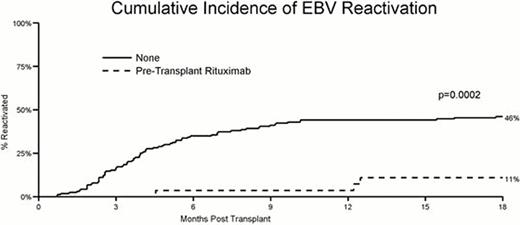Abstract
Abstract 460
Epstein-Barr virus (EBV)-associated post-transplant lymphoproliferative disease (PTLD) remains an important complication of allogeneic stem cell transplantation (alloSCT). Monitoring of EBV genomes in blood using quantitative PCR (EBV qPCR) coupled with pre-emptive administration of Rituximab in response to high-level EBV reactivation has emerged as a strategy to reduce mortality from PTLD. However, the effect of pre-transplant Rituximab therapy on the risk of EBV reactivation and survival post-alloSCT is unknown.
This retrospective study examined 193 consecutive adult patients undergoing T cell depleted or cord blood alloSCT at University Hospital Birmingham, UK (UHB) and Nottingham University Hospital, UK (NUH) between May 2009 and April 2011. Median age at transplant was 54 years (range 16–73 years). Conditioning was reduced intensity in 84% and myeloablative in 16%. Stem cell source was matched unrelated donor in 70%, sibling in 24% and cord blood in 6%. T cell depletion was with in vivo Alemtuzumab in 89% and ATG in 6%. Patients were monitored by EBV qPCR whole blood assay, performed every 1–2 weeks post-transplant. EBV reactivation was defined as a single positive EBV qPCR result, whilst high-level EBV reactivation was defined according to institutional thresholds; 30,000 and 10,000 EBV genomes/ml for UHB and NUH respectively. All patients with high-level reactivation were pre-emptively treated with Rituximab.
Median follow-up was 23 months (interquartile range [IQR] 18–30 months), with EBV qPCR testing for a median of 8 months (IQR 4–13 months) post-transplant. The cumulative incidence of EBV reactivation, adjusting for the competing risk of death, was 41% at 2 years post-transplant. Amongst those reactivating, the median time to EBV qPCR positivity was 120 days (IQR 77–198 days). High-level EBV reactivation was observed in 34/193 (18%) patients, accompanied by PTLD in 10 patients (4 biopsy-proven and 6 probable cases). Of patients developing high-level EBV reactivation, in 30/34 (88%) the interval from first EBV qPCR positivity to high-level reactivation was less than 4 weeks, with 15/34 (44%) exhibiting high-level reactivation at first qPCR positivity.
In univariate analysis, significant predictors for EBV reactivation were older age (hazard ratio [HR] 1.02 per year; p=0.04), male sex (HR 1.75; p=0.03) and T depletion with ATG (HR 4.8; p<0.0001). A primary diagnosis of non-Hodgkin lymphoma (NHL) carried a significantly reduced risk of EBV reactivation (HR 0.04; p=0.0018). Reduced intensity conditioning carried an increased risk of reactivation with borderline significance (HR 2.04; p=0.07). Donor type and HLA-mismatch were not significant risk factors. Acute graft-versus-host disease (GvHD) and cytomegalovirus (CMV) reactivation were also not significantly associated with EBV reactivation.
Twenty-nine patients received Rituximab in the year preceding alloSCT, of whom 25 had NHL, 3 had chronic lymphocytic leukaemia (CLL) and 1 had acute lymphocytic leukaemia. Only one of these patients developed EBV reactivation by 12 months post-transplant - a patient with high-level reactivation associated with PTLD. Two other patients developed low-level EBV reactivation beyond 12 months. In univariate analysis, pre-transplant Rituximab was highly predictive for (lack of) EBV reactivation (HR 0.15, 95% confidence interval [CI] 0.05–0.48; p=0.0002; see figure). Applying a multivariate model including age, sex and ATG use, pre-transplant Rituximab remained highly predictive (HR 0.15, CI 0.05–0.47; p=0.0012). As expected, strong confounding between NHL and pre-transplant Rituximab made a model including both uninformative. There was no significant association between pre-transplant Rituximab and the risk of relapse, acute GvHD or CMV reactivation.
Overall mortality was 50% at 2 years, with 4 deaths due to PTLD. There was no evidence of a link between EBV reactivation and survival (p=0.33). Pre-transplant Rituximab was associated with a significantly reduced risk of mortality (HR 0.49, CI 0.23–1.00; p=0.05) although the aforementioned confounding with NHL should be noted.
We report the novel and clinically important finding that pre-transplant Rituximab is associated with a markedly reduced risk of EBV reactivation and a possible survival benefit after alloSCT. Our data make a strong case for prospectively evaluating the role of Rituximab in allograft conditioning.
Off Label Use: Rituximab for prevention of Epstein-Barr virus reactivation after allogeneic stem cell transplantation. Fox:Roche: Honoraria.
Author notes
Asterisk with author names denotes non-ASH members.


